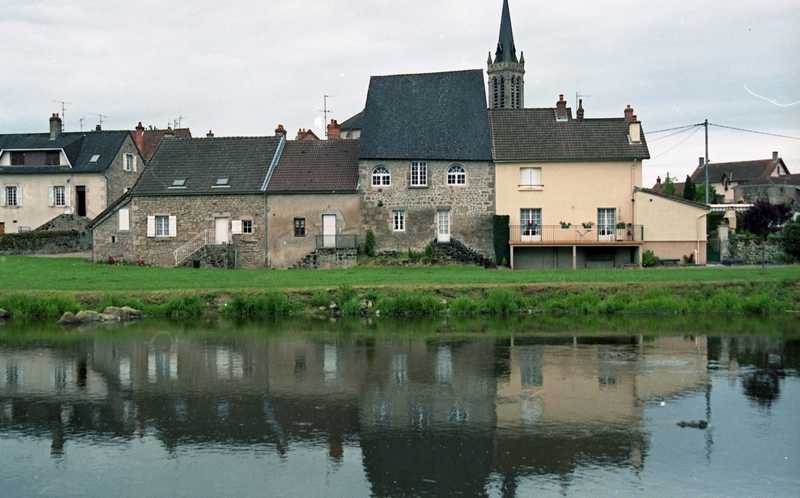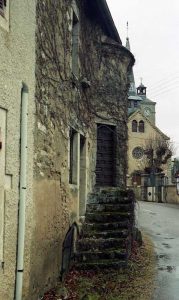Originally posted 2016-07-30 18:45:38.
In the past walls were rendered and plastered with lime. Lime is a truly wonderful material that can be bent to a whole series of uses, but as a render on stone it is unsurpassed. It ‘breathes’, allowing moisture to escape and suppressing damp walls. This is because it is very porous. So why are there damp walls in so many old houses today?
Fashion
In the 19th century gypsum plasters became available. In France they were produced in the area round the capital, which is where the term “Plaster of Paris” comes from. Gypsum plaster is easy to apply and can be polished completely smooth relatively easily. Furthermore it is ideal for wallpapering, which lime plaster is not. Fashion dictated that gypsum plaster and wallpaper were to become almost universal as internal finishing for walls.
The problem is that while gypsum plaster is porous too, it is also organic, and literally soaks up water, holding it within its structure, which lime plaster does not. This leads to damp walls, because dampness will climb up the gypsum plaster, leaving the characteristic black staining. Not Good.
The only cure for this is to remove the gypsum plaster from the damp walls. At very least you must completely excise the lowest six inches, leaving the stone bare. Frankly, however, this is never going to be ideal and it should all be removed.

Making a bad situation worse.
The French managed to make a bad situation worse by inventing a curse called briques cloisonnées. These hollow clay bricks, and the two-inch thick internal walls they are used to build, are everywhere in France.
Unfortunately they are normally cemented together with a special form of gypsum plaster, which cheerfully sucks up any moisture it can. Once the wall has been plastered with more gypsum and papered, things really get out of hand. Think big vertical sheet of blotting paper. I have seen damp walls which, quite literally, had in parts been reduced to two sheets of paper separated by a mush of damp dust. I’m not joking.
Now there is no problem at all using either briques cloisonnées or gypsum plaster in the upper stories of the house,. This is the proper place for them, allowing madame to have elegantly wallpapered bedrooms. But on walls built on ground which is already moist, they are an invitation for damp walls and nothing more. My advice is to get rid of all of it.
Unfortunately, many owners in the past did not share this view. They believed that rising damp was the problem. But then a solution, or so they thought, came along. Cement. Suddenly, damp walls were being treated to a waterproof “tanking” coat of 3:1 cement mortar. That’s when it really got bad.
Cement creates damp walls.
Putting a cement tanking mix on damp walls will cause water to climb up the wall till it can escape. Tank the wall to one metre, you get waist-level “rising damp.” Tank to head height, you get eye-level “rising damp.”
Then, confronted with dampness on the inside of their walls caused by the use of untested materials, owners delivered another body-blow. They replaced the original, breathing lime mortar on the outside of the wall with a cement render. And people blame the original builders and their unsophisticated ways for dampness!
Most emphatically not. Many of these houses were standing and served as healthy, happy, comfortable homes for hundreds of years . That was before the thoughtless application of inappropriate modern technologies started causing problems.
What can be done?
So what is to be done? Well, forget all those silicone damp-proof courses, electromagnetic devices, hygroscopic gizmos. None of these—not one—works at all, and they will all just cause more bother. Every one of these modern solutions is as futile a waste of time, effort and money as the next and may even be as serious a cause of irreparable damage as tanking mix was.
If, and it’s a big if, there is room, removing stone from the walls and inserting lengths of 3-inch thick-walled clay pipe at 600mm centres will actually reduce the problem. It may be all the owner can do, since attempts to remove the cement tanking mix and cement render that caused the problems may make the wall unstable. Most old French houses are rubble-walled, mortared with clay in very old examples, or relatively weak lime mortars in later. Walls like this simply can’t stand being jack-hammered to remove cement, and may actually collapse.
Gypsum.
If you are one of the lucky ones, cement, at least, has not been allowed into your house. But you will probably still be faced with removing several skip-loads of sodden, blown gypsum plaster and what remains of your interior walls. These must all be replaced.
Don’t use clay bricks or gypsum on the ground floor. You can use lightweight concrete blocks set on conventional plastic damp-proof course. Render them with lime mortar and paint with limewash. This will not hold moisture and will resist the ugly mildew that occurs when gypsum becomes damp.
Remember that lime plaster must always be applied in at least two coats, otherwise the pattern of the underlying blockwork will show through.
However you are likely to still have a problem, because of our modern lifestyle with constant, limitless supplies of piped water and flush sanitation.
Damp walls are caused by living.
Let me say it again: water has to go somewhere. If you let it in, you have to let  it out. Yes it is better to stop it getting in, but if you simply cannot do this, then you have to get it out before it soaks the walls. Our feeble modern constitutions cannot stand the wee bit draught that used to help protect the building. We make matters worse by using gas to cook and heat, eating rice and potatoes instead of bread, insisting on showers and baths every day and at the end, simply breathing.
it out. Yes it is better to stop it getting in, but if you simply cannot do this, then you have to get it out before it soaks the walls. Our feeble modern constitutions cannot stand the wee bit draught that used to help protect the building. We make matters worse by using gas to cook and heat, eating rice and potatoes instead of bread, insisting on showers and baths every day and at the end, simply breathing.
We can’t prevent a great deal of this; I am not advocating a return to medieval life. But in order to minimise problems we do have to realise what is going on and do what we can to reduce its impact.
Unfortunately, due to ‘modernisation’, the walls probably contain more moisture than they should. This wants to evaporate and will, if you let it. If there is no further moisture introduced, eventually the amount of water in the wall and the relative amount of vapour in the air will stabilise and the wall will feel dry.
Condensation.
Unfortunately a thing called Latent Heat of Evaporation means that as the moisture evaporates it chills the wall. If there is an excess of vapour in the air, when it touches the cooled wall it will condense, making the wall damp again. Now, the condensation process releases Heat of Evaporation and warms the wall, so you might think all would be well, and as soon as the input of extra moisture is reduced the wall would dry out again, but it won’t. Because the exchange is not 100% efficient, in fact very much less so, the wall gets progressively wetter under the daily assault of condensation.
It is this condensation that is so often misrepresented as “rising damp” by the snake-oil salesman who would have you buy one of the modern solutions described above. None of them will work, because the problem is not rising damp at all, but condensing damp. It’s not coming up from the ground through the wall, it’s landing on the wall from inside the building. It’s water you put there.
There may indeed by a slightly raised level of moisture in the lowest foot of a stone wall, but that is not the problem. That small amount of moisture is quite normal. We created damp walls with our modern habits and lifestyle.
Options
The owner faced with this problem is limited in his or her options. Gypsum plaster and rotten bricks can be skipped, but it may not be feasible to remove a tanking coat.
The first and best thing to do is to reduce the input of water from outside by attending to the building’s structure and drainage. Once this is done you must examine the way life is lived in the home.
Consider using a solid wood cooker rather than a gas one, if you live somewhere where wood is easily available. Unfortunately the electricity supply in many rural areas is just a bit marginal for cooking by electricity.
Central heating is very effective at drying the structure. However it tends to come hand-in-hand with better draught-prevention, which is not altogether a good thing. Closed wood-burning stoves have the same advantages and drawbacks.
Forced Ventilation.
Make sure there is plenty of forced ventilation in the kitchen and bathroom areas and evacuate steam as quickly as you can. In France any DIY shop will sell a centralised fan vent system called a VMC, which is left running all the time. These are excellent and inexpensive but should be supplemented with powerful switched fans in both the kitchen and bathroom areas.
In recent years it has become possible to buy small, domestic dehumidifiers. Placing one of these in a busy kitchen and another in the bathroom will make an enormous difference. You will be simply staggered at the amount of water that collects in the machine’s reservoir.
This water, by the way, is distilled and can be used for topping up your car battery. These are cheap to run and have the advantage of producing a constant stream of warm dry air. However they should be seen as the “final touch” to really dry out the air, after you have attended to all the structural faults.
A fire in the hearth
However, despite all the benefits modern technology can bring, the biggest help of all is to ensure that there is at least one big, old-fashioned wood-burning fireplace and that it works properly. Run this beast daily in cold and damp weather and you’ll see an immediate improvement.
It’s relatively easy to install a flap in the throat to minimise draughts when the fire is not being used. If you fit a really heavy cast-iron fireback, a lot of heat will be radiated back into the room, making the fireplace much more efficient. It is also possible to buy a grate that is made of thick-walled pipe instead of solid metal, which you then attach to a blower. This will pump a lot of hot dry air out, that can be ducted anywhere you like. These are available at DIY stores like Castorama and cost around 200 Euros.
And in the end, fires like these are inimitable in the joy they bring to a house. As they say, it’s not a home without a hearth.
Updated 23 July 2017.
If you have found this article useful or interesting, please leave a tip. Click the big yellow button!





Great article and full of home truths – thanks
I like how you mentioned that water has to go somewhere and that if you cannot stop it from getting in then it could soak up the walls. My brother is thinking about hiring a professional to treat the rising salt damp in his basement because the house was built using stone instead of concrete; and, he wants to stop moisture from accumulating in the carpet. It seems like a good idea for him to hire a reputable professional that could help with the dampness accruing in his home.
Probably pointless. There is no ‘cure’ for damp other than 1 stopping water getting in and 2 getting rid of it quickly if it does. Barrier techniques just don’t work, though they make plenty of money for builders